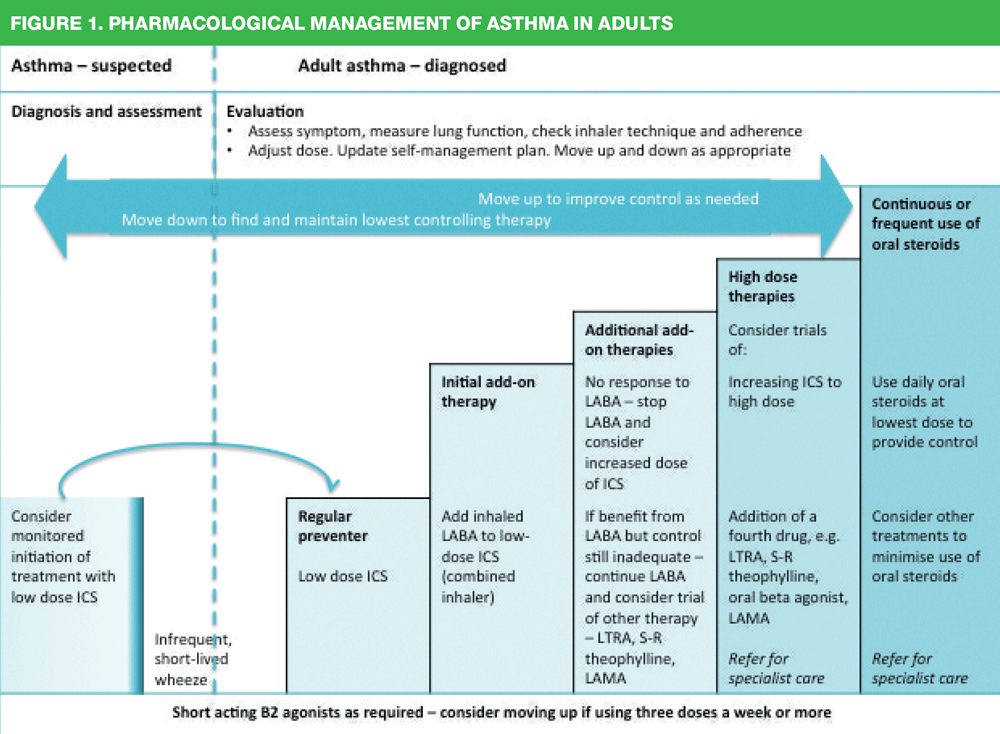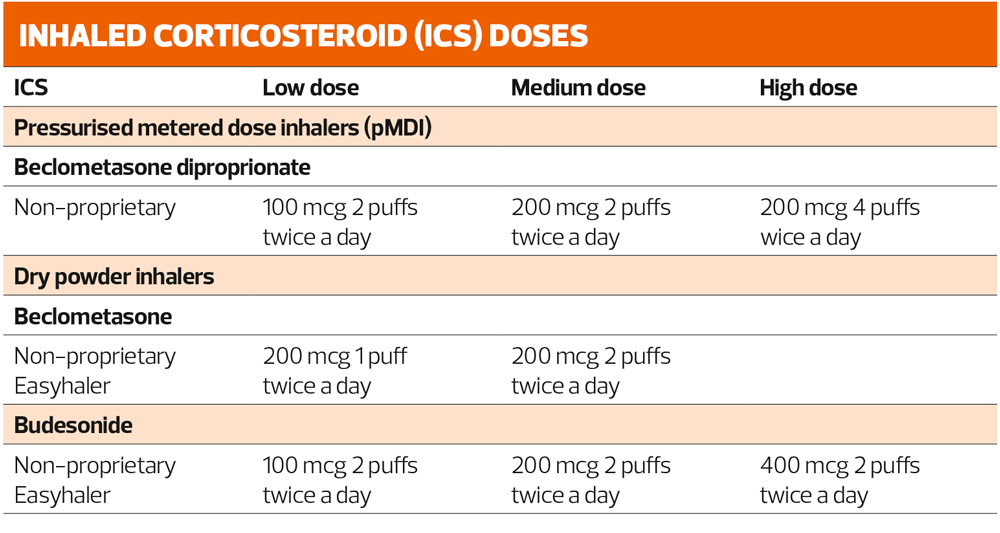
British guideline on the management of asthma
The 2016 update of the BTS/SIGN asthma guideline makes important changes to how we make a diagnosis and how we think about and describe the therapeutic pathway
The British Asthma Guideline also reinforces the need to base diagnosis of asthma on the probability of the condition, confirmed by objective testing, rather than the spirometry-based approach favoured by NICE in its draft guidance.
The Pharmacology section has been extensively revised, with significant changes to the presentation of the familiar steps of asthma management, and to comparing inhaled corticosteroid (ICS) strengths.
The Guideline recommends that anyone prescribed more than one short acting bronchodilator (SABA) inhaler device a month should be identified and have their asthma assessed urgently.
Comparing other ICS with beclomethasone dipropionate (BDP) has not been helpful since CFC-free inhalers were introduced, so the new banding of ICS by strength is more accurate and intended to be more straightforward in practice.
KEY POINTS
- Use of more than one SABA inhaler a month should trigger urgent review and action
- Use of a long-acting antimuscarinic agent (LAMA) is now recommended as an additional add-on therapy for patients whose symptoms are uncontrolled on ICS plus long-acting beta2-agonist (LABA)
- All patients on high dose therapies and continuous or frequent use of oral steroids should be referred to specialist care
- Inhaler prescriptions should be written by brand name to avoid patients being given an inhaler they have not been trained to use.
DIAGNOSIS
The diagnosis of asthma is a clinical one. There are no gold-standard diagnostic criteria means that it is not possible to make evidence-based recommendations on how to make a diagnosis. Tests influence the probability of asthma but do not prove a diagnosis. Asthma status and diagnostic test results vary over time.
Consider a diagnosis when one or more of the following symptoms is present:
- Wheeze
- Breathlessness
- Chest tightness
- Cough, plus
- Variable airflow obstruction
The diagnosis of asthma is based on the recognition of a characteristic pattern of respiratory symptoms, signs and test results and the absence of any alternative explanation for them.
INITIAL STRUCTURED CLINICAL ASSESSMENT
Patient presenting with respiratory symptoms (wheeze, cough, breathlessness, chest tightness)
- More than one of the above symptoms with periods of no or minimal symptoms between episodes
- Documented history of acute attacks triggered by viral infection or allergen exposure (or NSAIDs or beta blockers) with symptomatic and objective improvement with treatment
- Recurrent intermittent episodes of symptoms triggered by allergen exposure and/or viral infections exacerbated by exercise and cold air (and emotion or laughter in children)
- Wheeze confirmed on auscultation. Distinguish wheeze from stridor or rattly breathing
- Repeatedly normal chest examination when symptomatic reduces the probability of asthma
- Historical record of variable peak expiratory flow (PEF) or forced expiratory volume in 1 second (FEV1)
- Absence of symptoms, signs or clinical history to suggest alternative diagnosis
Options for investigations
- Reversibility
- PEF charting
- Challenge tests
- FeNO (fractionated exhaled nitric oxide)
- Blood eosinophils
- Skin-prick test, IgE
High probability
Where the probability of asthma is high, or for children unable to undertake spirometry, watchful waiting (if asymptomatic) or commence treatment (low dose ICS for 6 weeks) and assess response objectively
Intermediate probability
Spirometry is the preferred initial investigation, with bronchodilator reversibility as appropriate, for adults and children old enough to undertake a reliable test
Low probability
Investigate for alternative diagnoses
NON-DRUG MANAGEMENT
All people with asthma (and/or parents/carers) should be offered self-management education including a written personalised asthma action plan (PAAP) – available at asthma.org.uk/control
Adherence to long-term asthma treatment should be routinely and regularly assessed
Secondary preventive measures – e.g. physical and chemical methods of reducing house dust mite levels in the home, and ionisers should NOT be recommended. Smoking cessation support and weight-loss interventions should be considered where appropriate. Breathing exercise programmes can be offered in addition to drug treatment to reduce symptoms.
PHARMACOLOGICAL MANAGEMENT (Table 1 and Figure 1)
Aim
- No daytime symptoms
- No night-time awakening due to asthma
- No need for rescue medication
- No asthma attacks
- No limitations on activity including exercise
- Normal lung function (FEV1 and/or PEF >80% predicted or best)
- Minimal side effects from medication
Approach to management
1. Start treatment at level most appropriate to initial severity
2. Achieve early control
3. Maintain control by:
- Increasing treatment as necessary
- Decreasing treatment when control is good
Prescribing inhalers
- Prescribe inhalers only after patients have received training in the use of the device and have demonstrated satisfactory technique
- Choice of device may be determined by the choice of drug
- If the patient cannot use a device satisfactorily an alternative should be found
- Titrate medication against clinical response
- Reassess inhaler technique as part of structured clinical review
- Avoid generic prescribing of inhalers as this may lead to patients being given a device which they are unable to use properly
- In children a pMDI and spacer (with face mask if needed) are the preferred method of delivery of bronchodilators and ICS
DELIVERY OF CARE
- People with asthma should be reviewed regularly by a nurse or doctor with appropriate training in asthma management
- Review should included a written action plan
- It is good practice to audit percentage of adults reviewed annually. Focus on patients overusing bronchodilators, on higher dose therapies, with asthma attacks or with complex needs
WHEN TO REFER
- When diagnosis is unclear
- When occupational asthma is suspected (symptoms that improve when patient is not at work, adult-onset asthma and workers in high-risk occupations, e.g. bakery, spray painting, metalwork, chemical processing or other jobs with exposure to dust or fumes) [See Resources]
- When patient requires high-dose therapies or the addition of a fourth drug to achieve control, or is on continuous or frequent use of oral steroids
- When patient has difficult asthma (persistent symptoms and/or frequent asthma attacks despite treatment with high-dose therapies)
Patients presenting with features of acute severe or life-threatening asthma should be referred urgently to an Emergency Department and may require admission if their symptoms persist after initial treatment
RESOURCES
British guideline on the management of asthma, 2016 https://www.sign.ac.uk/our-guidelines/british-guideline-on-the-management-of-asthma/
Asthma UK. Action plans and resources. www.asthma.org.uk/control
Guidelines for the identification, management and prevention of occupational asthma. www.bohrf.org.uk/content/asthma.htm
Related guidelines
View all Guidelines

